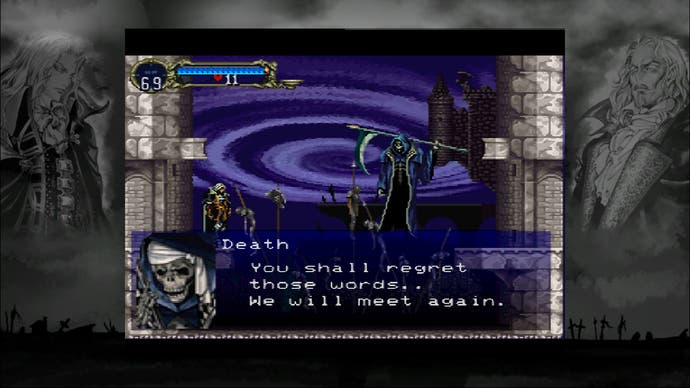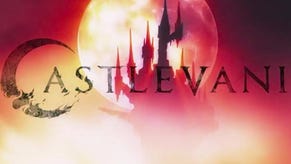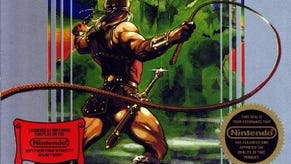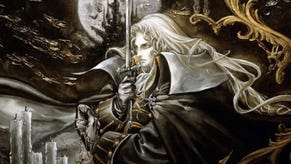Castlevania: Symphony of the Night
Standing ovation.
Even in 1997 this was an anachronism. Videogames' bright new horizon was three-dimensional and Sony's first console wunderkind the only viewing tower worth climbing. The PlayStation future was all about Lara Croft's curvaceous polygons, Gran Turismo's reflective bonnets and screen-filling Tekken sucker-punches. It was the Chemical Brothers serenading Wipeout races and the Designer's Republic packaging. Aspirational pixels backed by aspirational music promoted by aspirational faces; not much room for two-dimensional gothic oddities in this too-cool-for-school marketing vision.
As such, Symphony of the Night, with its dank 2D walls, brooding orchestral soundtrack and Street Fighter-esque special moves stole across videogaming's busy vista mostly unnoticed the first time round. But not completely unnoticed. Those with eyes to see its exquisite design, extraordinary scope, aesthetic elegance and coherence were quick to evangelise. The game's underground following bustled and grew until copies of the game were changing hands on ebay for £60 and upwards. Symphony of the Night had made the celebrated canon and every discerning games player wanted a look.
And that, in short, is why Microsoft's been so keen to accommodate this, the Castlevania series' debated highpoint, tripling the 50MB size restriction of all its Xbox Live Arcade games specifically to allow it into its line-up of mixed importance. Symphony of the Night is to action-adventure fans what Mario 64 is to platform lovers, Monkey Island is to point and click autistics or Final Fantasy VII is to incurable geeks. It's important, beloved and, crucially, it expands XBLA's remit to include fan-favourite console titles as well as those arcade classics such as Pac-Man, Defender and, er, Teenager Mutant Ninja Turtles.
The 2D Castlevania series, for newcomers or those unfortunate enough to have only experienced Konami's awkward and comprehensively unsuccessful stabs at 3D-ing it, are straightforward side-scrolling, platform-jumping, puzzle-solving, monster-fighting, hack-and-slash, RPG affairs.
In other words it draws the best elements from each genre to Super Metroid effect, building a deep but understandable action adventure and setting it in a cold, 1700's Romanian castle. In this instance, you have a jump button, two attacks (one for the left hand and one for the right), a quick retreat, backwards slide and, at least to begin with, that's it. You move from room to cavernous room, uncovering the castle, filling in the blanks on a map, slowly upgrading your abilities and defeating ever more inventive bosses.

For players familiar with the GBA and DS outings there are many similarities but, where those games shoehorn increasingly camp Japanese teenage love dramas into their narratives, this game revels in gothic unease: more Bram Stoker than Wes Craven. This is helped both by Ayami Kojima's mature and stylized character designs (indeed Kojima and her style was dropped from the two recent DS games for fear it was alienating a younger audience) and by the scenario in which you play as one Adrian Fahrenheit (nicknamed Alucard), Dracula's own son. Your aim is to explore your estranged father's castle (which apparently appears only once a century) and find out why Richter Belmont, protagonist from the previous game in the series, has mysteriously vanished.
Those familiar with the earlier Castlevania games will be surprised to discover you don't carry a default whip for protection here. Instead, an RPG-lite framework is in place allowing for various types of weapon (either gathered from enemies or bought from the castle's friendly librarian (!) to be equipped. The RPG trappings don't end there. Defeating enemies will harvest experience and, when Alucard levels up, his various attributes upgrade, providing necessary incentive to finish off every enemy you encounter. Special moves can be triggered by using the kind of tortuous D-pad manipulations more commonly found in 2D fighters and you also discover relics around the castle which add new abilities (such as allowing you to see the names of enemies or, more significantly, adding a double jump function).
Of primary importance is your map (viewable on the 360 with the L-trigger). This opens up room by room as you work through the castle showing all the little openings you can only explore once you have the appropriate skills. Specifically, many areas can only be accessed once you've found the three souls (Wolf, Bat and Mist), which allow Alucard to change form. Famously, this castle, by fulfilling certain conditions, can be explored in a mirrored version of itself thus opening up the possible completion tally to the renowned but mathematically implausible, 200.6%. Uncovering the whole castle soon becomes an obsession of Pokémon-esque potency and, once the game has its claws into you, you won't find rest until the job's done.
So as to this conversion? The import into HD sadly hasn't seen each sprite redrawn - instead the kind of waxing effect recognizable to those used to playing with emulators is (optionally) employed to smooth over the graphics. The screen defaults to a 4:3 aspect ratio with big artwork borders but, mercifully, the dimensions can be comfortably stretched to fit a widescreen TV and, once done, the game looks pretty enough.

Simmering the game down to sub-100MB has been tough and people who probably need to get more sunlight will notice slight downgrades such as dropped sound effects and clipping on the voice acting from the nuclear-powered compression the game's clearly been subjected to. On the whole, the changes are near imperceptible and do nothing to lessen the experience. Sadly (or happily depending on your stance) nothing has been done to replace Symphony of the Night's so-bad-it's-almost good voice acting employed for the localisation. Indeed, while enjoying a fantastic story, the text was clearly translated by someone for whom English is a second language and some of the phrasing is unintentionally very funny in that endearing-but-ultimately-irritating Japlish way.
So what makes Symphony of the Night so much more lauded than the more recent iterations? Cynics might argue it's because it was the first to arrive and that nostalgia has clouded the issue. But playing through the game afresh on 360 and that's just not the case. Partly it's the ambiance - the unquantifiable atmosphere generated by the inspired sprite work, the hammy acting, the crushing orchestral soundtrack and inventive designs. Partly it's because of the higher resolution of the PS1 compared to the handhelds - the fact that, in relation to your character's size, much more of the castle can be displayed on any one screen - lending the scenery a grandness since unmatched. But mainly it's the precise feel of controlling Alucard, the brilliantly pitched learning curve and the way new abilities unfurl themselves to expand your tool kit with expert pitch and composition.
Despite all of this, in 2007 this is still an anachronism. Videogames' bright new horizon is three-dimensional and Microsoft's second console wunderkind the only viewing tower worth climbing (until Friday at least). The 360 future is all about Marcus Fenix's curvaceous polygons, Forza Motorsport's reflective bonnets and screen-filling Virtua Fighter 5 suckerpunches. Aspirational pixels backed by aspirational music promoted by aspirational faces: not much room for two-dimensional gothic oddities in this too-cool-for-school marketing vision. But nevertheless, as those with eyes to see will be quick to evangelise, Symphony of the Night presents exquisite design, extraordinary scope, aesthetic coherence and transcendent elegance mostly unmatched elsewhere on Xbox Live Arcade, or anywhere else for that matter.








